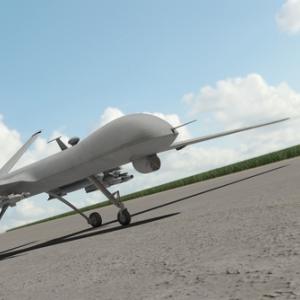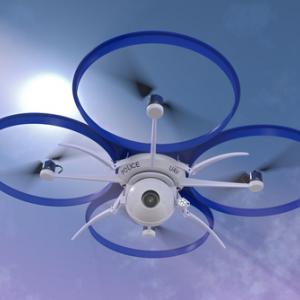

Obama has personally ordered drone strikes. Keith Tarrier and spirit of america / Shutterstock
For centuries, followers of Jesus have wondered how they should relate to states and governments. Recent documents from Amnesty International, Human Rights Watch, and the United Nations bring such concerns to the fore, highlighting the cruel collateral damage of many of President Barack Obama’s personally ordered drone strikes — strikes that according to the president, are legal and in accord with international law, use technology that is precise and limit unnecessary casualties, eliminate people that are real threats, and prevent greater violence.
Rather than considering the humanity of our (perceived) enemies and seeking reconciliation and restorative justice, we default to catching and killing. In doing so, we give the widest berth possible to Jesus's teachings and examples of self-sacrificial enemy love. In both Matthew 5 and Luke 6, Jesus tells us that to love our enemies is to be children of God, for radical love and kindness are his nature and his perfection. Loving enemies is essential to anyone who would claim God as his or her Father. Jesus said, "Love." Not, "Love unless you happen to be the ones in charge and in possession of firepower. In that case, kill the bastards."
We are charged with loving our world indiscriminately, self-sacrificially, and with great humility, and that should always inform our relationship with the state and government.
In response to criticism, the U.S. has drastically reduced the number of drone strikes in Pakistan and is limiting them to “high-value targets.” The Associated Press reports:
The CIA has been instructed to be more cautious with its attacks, limiting them to high-value targets and dropping the practice of so-called "signature strikes" - hitting larger groups of suspected militants based purely on their behavior, such as being armed and meeting with known militants, said a current U.S. intelligence official and a former intelligence official briefed on the drone program. …
Two other senior American officials said the U.S. scaled back the number of attacks and tightened up its targeting criteria as a concession to the Pakistani army, considered the most powerful institution in the country and the final arbiter on the future of the drone program.
Read more here.
The ACLU and the Center for Constitutional Rights have sued former Pentagon officials over the drone strikes that killed three U.S. citizens in Yemen. At a hearing in federal court on Friday, an Obama administration lawyer argued that courts should stay out of national security decision making. McClatchy News reports Judge Rosemary M. Collyer wasn’t so sure:
A Republican-appointed judge sounded dubious about the expansive claim, saying she was “really troubled” by assertions that courts are completely shut out of the drone strike debate. But for other legal reasons, the judge also sounded hesitant about a lawsuit targeted at top military and intelligence officials for violating the constitutional rights of U.S. citizens blown up in foreign lands.
Read more here.
In the past few months, drone attacks in Afghanistan, Pakistan, and Yemen have dwindled to only a few. But the use of drones for unarmed surveillance has dramatically grown, giving the U.S. military unprecedented capabilities to track activities around the world. The Washington Post reports:
Over the past decade, the Pentagon has amassed more than 400 Predators, Reapers, Hunters, Gray Eagles and other high-altitude drones that have revolutionized counterterrorism operations. Some of the unmanned aircraft will return home with U.S. troops when they leave Afghanistan. But many of the drones will redeploy to fresh frontiers, where they will spy on a melange of armed groups, drug runners, pirates and other targets that worry U.S. officials.
Read more here.

Early Wednesday morning, at least 17 people were killed in the first U.S. drone attack in Pakistan since May 28.
According to NBC News:
“PESHAWAR, Pakistan -- At least 17 people were killed in a U.S drone attack in the volatile North Waziristan tribal region in northwest Pakistan early Wednesday, officials said.
"Local residents and security officials said the aircraft fired four missiles and struck a house at Sara-e-Darpakhel area of Miranshah, which is located near the Afghan border.
"'I never heard such a huge drone strike before,' local resident Nasrullah Khan said. 'They simultaneously fired four huge missiles and jolted the entire town.'"
Al Jazeera reported that the Pakistan foreign ministry condemned the attack:
“In a press release on Wednesday, the Pakistan foreign ministry said the strikes were a violation of Pakistan’s sovereignty and territorial integrity. The statement described the attacks as 'counterproductive, entail loss of innocent civilian lives and have human rights and humanitarian implications.'"

Nine foreign climbers in the Himalayas in a remote part of northern Pakistan were killed Saturday night by a unit of the Pakistani Taliban. A Taliban spokesman claimed the killings were by a new unit set up to send a message against drone strikes by attacking foreigners. Al Jazeera reported:
“Taliban spokesman Ehsanullah Ehsan telephoned the AFP news agency to say that the killings were intended to avenge the death of the second in command of the Tehreek-e-Taliban (TTP) in a US drone strike late last month.
"We did it and we claim responsibility for this attack," Ehsan said in the call from an undisclosed location.
"One of our factions, Junood ul-Hifsa, did it. It is to avenge the killing of Maulvi Wali ur-Rehman," he said.
"We want to convey to the world that this is our reply to US drone attacks," he added.”
Read more here.

Dozens of peace activists walked into Des Moines, Iowa, yesterday, following a nearly 200-mile march from Rock Island, Ill. The march ended with a rally at the gate of the Iowa Air National Guard's 132nd Fighter Wing, where drone pilots will soon be trained. The Des Moines Register reported:
“Dozens of protesters walked during each leg of the march, which was organized by the Chicago-based Voices for Creative Nonviolence. The group covered about 15 miles a day, camping and staying in host houses along the way.
“Organizers said the march was also to protest the development of drone technology at the Quad Cities Manufacturing Lab in Rock Island. According to a company brochure, the lab manufactures UAV, or unmanned aerial vehicle, engine components.”
Read more here.

The most recent reported drone strike in Yemen, said to be five missiles fired at an SUV, killed at least six people. Reports from local tribal leaders in Yemen say that five were suspected Al Qaeda members, including a local leader. But one of those killed was a 10-year-old boy, brother of the AQ leader. Adam Baron of McClatchy News reports from Yemen:
“If an apparent U.S. drone strike this month in the village of Mahashama had killed only its intended targets – an al Qaida chief and some of his men – locals might’ve grumbled about a violation of Yemen’s national sovereignty and gone on with their lives.
“But the strike also killed a 10-year-old named Abdulaziz, the younger brother of the targeted militant, Saleh Hassan Huraydan, according to local tribal leaders and Yemenis with close ties to the al Qaida branch here. And that set off a firestorm of complaints that underscores how American airstrikes can so outrage a community that even though al Qaida loses some foot soldiers, it gains dozens of sympathizers.
“Killing al Qaida is one thing, but the death of an innocent person is a crime that we cannot accept,” said a sheikh from the area…”
Read more here.

In a Senate Judiciary Committee hearing Wednesday, FBI Director Robert Mueller admitted that drones are used for some law enforcement missions in the U.S. Today, the Washington Post reported that there have been at least four such operations since 2010. According to the Post:
“The FBI has received clearance from federal aviation officials to conduct drone surveillance operations in the United States on at least four occasions since 2010, according to public records and U.S. officials.
“The FBI began seeking permission in 2009 from the Federal Aviation Administration to fly drones domestically and received authorization for its first operations a year later, according to documents released Thursday by the FAA. The documents provide virtually no detail on where the FBI has operated drones in U.S. airspace, for what purpose or how long the missions lasted.”
Read more here.

Image still from 'Dirty Wars' documentary
Days before President Barack Obama's high-profile speech on drones and U.S. counterterrorism efforts, Sojourners sat down with investigative reporter Jeremy Scahill to take an inside look at U.S.-led covert wars and the drones that have become an integral part of our global “war on terror.”
His thesis?
"After years of traveling in these countries, I really believe that we’re creating more enemies than we’re killing.”
In some respects, drones are simply a new tool of old empire. Scahill, author of Dirty Wars: The World is a Battlefield and producer of the documentary of the same name, now in theaters, calls this an "unending war ... being legitimized under a popular Democratic president, who is a constitutional lawyer by trade.”
Indeed, within five years, the Bush administration's invasion of Iraq for terrorist attacks the country did not commit has transformed under the Obama administration into pre-emptive assassinations halfway around the world, for crimes citizens have not yet committed. The result, Scahill suggested, is our collective complicity to “unending war.”

Military drone, F.Schmidt / Shutterstock.com
A fundamental principle [of ancient Greek tragedy], often overlooked, is that the double and the monster are one and the same being.
- René Girard, Violence and the Sacred (p. 160)
The debate about the use of drone strikes in the so-called “War on Terror ” has shed light on an inevitable calculus of war: how many civilian casualties can be tolerated in pursuit of our goals? President Barack Obama, in his speech on May 23 at National Defense University, referred to the drone strikes in Pakistan, Yemen, and Somalia, admitting, “It is a hard fact that U.S. strikes have resulted in civilian casualties, a risk that exists in all war.” But of course, our wars and our use of drones were conceived as a legitimate response to the civilian deaths on 9/11 and a defensive maneuver to prevent future attacks.
Obama Defends Drone Attacks
In his speech, Obama further justified the use of drones by stating it reduces the number of civilian casualties compared to boots-on-the-ground wars. Though the numbers are hard to determine, it has been reported by the Canadian Broadcasting Corporation that civilian casualties caused by our invasion of Iraq number somewhere between 55,000 and 60,000. In Afghanistan, from the time reporting began in 2007, the Guardian reports that the total number of civilians who have lost their lives in the armed conflict to be 14,728. For drone strikes, the highest estimates put total civilian deaths at around 950, indisputably a better number.
The Illogical Logic of Violence
Reducing the number of deaths caused by our use of violence is a worthy goal, and Obama does seem genuinely engaged in drawing the number down. So for the sake of argument, I will take him at his word. But (you knew there was a but coming!), he is trapped, as so many of us are, within the logic of violence.

Rendering of a small police drone, Glenn Price / Shutterstock.com
At first I had no problem with domestic drones joining the plethora of surveillance cameras to “keep us safe.”
Big Brother — keeping his eye on me from above in stores, in traffic and everywhere else — would find my personal reality show boring. As a pastor, I’m used to living in a fishbowl. Besides, as John Calvin said, if you fear the eye of a human more than the eye of God, you have spiritual issues to address.
But then, there may be another problem with increased surveillance and flooding our nation’s skies with drones. Let’s take traffic cameras as an example.

The pace of U.S. drone strikes is dramatically slowing. During the month of May, there was one strike in Pakistan and one in Yemen. The new restrictions announced by President Obama in his May 23 speech may be having an effect.
So on a Friday afternoon, here’s some good news on the drone front. In the U.K., Domino’s Pizza released a video of an experimental "DomiCopter" remote-controlled drone delivering two pizzas. Huffington Post reports:
We're crossing our fingers that Domino's new "DomiCopter" -- a drone that delivers pizzas -- is real. In a recent test video, the contraption traveled about four miles in 10 minutes on a two-pizza delivery in the U.K.
Domino's hired creative agency T + Biscuits to develop and test out the contraption. Founder Tom Hatton told NBC that so far, the DomiCopter has been a success. "If anything it went quicker than a pizza boy," he said, pointing out that the DomiCopter doesn't need to stop at red lights. "We were amazed at how easy it was going to be."

Six British Christian peace activists were arrested and detained for 24 hours for protesting at the RAF base from which British drones in Afghanistan are controlled. It is the first anti-drone protest in the U.K. to result in arrests. Ekklesia reports:
Six peace activists, representing the group Disarm the Drones, have become the first in Britain to be arrested and charged for anti-drones related offences. The nonviolent peace activists managed to breach security at Britain’s top security drone control base in Lincoln.
The six, who are Christian peace campaigners, planted a peace garden in RAF Waddington yesterday morning (3 June 2013). They also displayed images of the victims of drone attacks and may have located the precise place where UK attacks are programmed.
Read more here.

In what was largely a formality following last month’s popular elections, Pakistan’s parliament yesterday elected Nawaz Sharif as prime minister. In Mr. Sharif’s first speech, he said that he wanted better relations with the U.S., but included among his priorities an end to drone strikes. According to the Associated Press:
"This daily routine of drone attacks, this chapter shall now be closed," Sharif said to widespread applause in the parliament hall. "We do respect others' sovereignty. It is mandatory on others that they respect our sovereignty."
But he gave few details on how he might end the strikes. Many in Pakistan say the strikes kill large numbers of innocent civilians — something the U.S. denies — and end up breeding more extremism by those seeking retribution with the U.S.
Read more here.

Akbar Ahmed, Islamic Studies chair at American University, writes in the New York Times this morning about the effect of both violent extremist groups and U.S. drone strikes on traditional tribal societies.
Drone strikes like Wednesday’s, in Waziristan, are destroying already weak tribal structures and throwing communities into disarray throughout Pakistan’s tribal belt along the border with Afghanistan. The chaos and rage they produce endangers the Pakistani government and fuels anti-Americanism. And the damage isn’t limited to Pakistan. Similar destruction is occurring in other traditional tribal societies like Afghanistan, Somalia and Yemen. The tribes on the periphery of these nations have long struggled for more autonomy from the central government, first under colonial rule and later against the modern state. The global war on terror has intensified that conflict.
…
In recent decades, these societies have undergone huge disruptions as the traditional leadership has come under attack by violent groups like the Taliban, Al Qaeda in the Arabian Peninsula and Somalia’s Al Shabab, not to mention full-scale military invasions. America has deployed drones into these power vacuums, causing ferocious backlashes against central governments while destroying any positive image of the United States that may have once existed.
Read more here.

A spokesman for the Pakistani Taliban confirmed that Waliur Rehman, the group’s second-in-command, was killed in yesterday’s drone strike. Ahsanullah Ahsan also announced that an offer to begin peace talks with the new Pakistani government was being withdrawn.The Associated Press reports:
The militant group had said earlier that it was open to peace talks. But Ahsan said Thursday that the Taliban believe the government approves of the drone strikes so they are withdrawing their offer of peace talks.
"We had made the offer for peace talks with the government with good intention but we think that these drone attacks are carried out with the approval of the government so we announce the end of the talks process," he said.
The incoming government, headed by Nawaz Sharif, promised in the campaign that it would work to bring about peace after years of violence. A U.S. drone has now called that into doubt.
Read more here.

In the news this morning are reports of a U.S. drone strike in Pakistan that killed seven people, including the unconfirmed death of the number two leader of Pakistan’s Taliban. It is the first strike since Pakistan’s election, and the first since President Obama’s speech last week on drone policy. Reuters reports:
A U.S. drone strike killed the number two of the Pakistani Taliban in the North Waziristan region on Wednesday, three security officials said, in what would be a major blow in the fight against militancy.
The drone strike killed seven people, Pakistani security officials said, including Taliban deputy commander Wali-ur-Rehman, in the first such attack since a May 11 general election in which the use of the unmanned aircraft was a major issue.
Wali-ur-Rehman had been poised to succeed Hakimullah Mehsud as leader of the Pakistani Taliban, a senior army official based in the South Waziristan region, had said in December.
Read more here.

News reports over the weekend had Pakistani reactions to President Obama’s Thursday speech on drones.
DAWN reported a statement from the Pakistani Foreign Office:
The Government of Pakistan has consistently maintained that the drone strikes are counter-productive, entail loss of innocent civilian lives, have human rights and humanitarian implications and violate the principles of national sovereignty, territorial integrity and international law.
The Associated Press reported that while Pakistanis welcomed the speech and its more restrictive rules on drone strikes, there was also disappointment that strikes will continue:
Obama has finally responded to the popular sentiment in this country, which is fiercely against the drones, and I think that shows a certain sensitivity," said Mushahid Hussain, chairman of the defense committee in Pakistan's Senate. "But for the people of Pakistan that is not good enough unless there is a cessation of drone attacks."
Several Pakistani officials and analysts noted that the President’s comments could help in improving relations between the U.S. and the new government in Pakistan.

Saying that drone killings were “effective” and “legal,” President Barack Obama defended the program in a policy speech this afternoon at the National Defense University. He also conceded that “To say a military tactic is legal, or even effective, is not to say it is wise or moral in every instance.”
The administration, he said, has “worked vigorously to establish a framework that governs our use of force against terrorists—insisting upon clear guidelines, oversight and accountability that is now codified in Presidential Policy Guidance that I signed yesterday.” He did not go into specific detail, but indicated it included more restrictive targeting criteria along with measures to prevent civilian casualties (“before any strike is taken, there must be near-certainty that no civilians will be killed or injured.”)
The president said that “the use of force must be seen as part of a larger discussion about a comprehensive counter-terrorism strategy. Because for all the focus on the use of force, force alone cannot make us safe.” And as an important part of that strategy, “we must help countries modernize economies, upgrade education, and encourage entrepreneurship.”
Over the next days and weeks, we will certainly learn more, and we will see what happens on the ground.
Read reports on the speech in The New York Times and The Washington Post.

The Obama administration formally acknowledged this afternoon that four American citizens have been killed by drone strikes, one intentionally and three who were not targeted. The New York Times reports:
In a letter to Congressional leaders obtained by The New York Times, Attorney General Eric H. Holder Jr. disclosed that the administration had deliberately killed Anwar al-Awlaki, a radical Muslim cleric who was killed in a drone strike in September 2011 in Yemen.
The American responsibility for Mr. Awlaki’s death has been widely reported, but the administration had until now refused to confirm or deny it.
The letter also said that the United States had killed three other Americans: Samir Khan, who was killed in the same strike; Mr. Awlaki’s son Abdulrahman al-Awlaki, who was also killed in Yemen; and Jude Mohammed, who was killed in a strike in Pakistan.
“These individuals were not specifically targeted by the United States,” Mr. Holder wrote.
Read more here.

President Barack Obama will deliver a major speech on drone policy tomorrow. And for a number of reasons—including a smaller number of important al Qaeda targets, issues such as bad weather to diplomatic problems, and concerns about the costs and benefits—the number of drone strikes being carried out is dropping. The New York Times reports:
But lost in the contentious debate over the legality, morality and effectiveness of a novel weapon is the fact that the number of strikes has actually been in decline. Strikes in Pakistan peaked in 2010 and have fallen sharply since then; their pace in Yemen has slowed to half of last year’s rate; and no strike has been reported in Somalia for more than a year.
In a long-awaited address on Thursday at the National Defense University, Mr. Obama will make his most ambitious attempt to date to lay out his justification for the strikes and what they have achieved. He may follow up on public promises, including one he made in his State of the Union speech in February to define a “legal architecture” for choosing targets, possibly shifting more strikes from the C.I.A. to the military; explain how he believes that presidents should be “reined in” in their exercise of lethal power; and take steps to make a program veiled in secrecy more transparent.
Read more here.

In a letter sent to the White House and the leadership of key Congressional committees, Bishop Richard E. Pates of Des Moines, Iowa, chair of the U.S. Catholic Bishops’ Committee on International Justice and Peace, wrote that the use of drones in counter-terrorism “raises serious moral questions.”
Even when viewed through the prism of just war principles, the use of unmanned aerial vehicles (UAVs) for targeted killings raises serious moral questions. The Administration seems to have focused narrowly on the just cause of protecting citizens, but other elements of the tradition pose significant questions, including discrimination, imminence of the threat, proportionality and probability of success. Targeted killing should, by definition, be highly discriminatory. The Administration's policy appears to extend the use of deadly force to alleged "signature" attacks and reportedly classifies all males of a certain age as combatants. Are these policies morally defensible? They seem to violate the law of war, international human rights law, and moral norms.
He concludes by asking:
We understand the necessity for operational secrecy in counter-terrorism, but isn’t it critical to have a public discussion of the terms of the Administration’s policy of employing drones for targeted killings? Don’t the moral and strategic issues involved require broader discussion? Shouldn’t a policy with such wide potential consequences be subject to public scrutiny, at a minimum by representative institutions in a democratic society?
Read more here.

One of the ongoing discussions of the U.S. drone program is who should control it. Having it under the military provides more oversight and accountability; having it under the CIA provides more secrecy. The Obama administration has apparently decided to begin moving control of at least some drone operations to the military. Reuters reports:
Four U.S. government sources told Reuters that the decision had been made to shift the CIA's drone operations to the Pentagon, and some of them said it would occur in stages.
Drone strikes in Yemen, where the U.S. military already conducts operations with Yemeni forces, would be run by the armed forces, officials said.
But for the time-being U.S. drone strikes in Pakistan would continue to be conducted by the CIA to keep the program covert and maintain deniability for both the United States and Pakistan, several sources said.
Ultimately, however, the administration's goal would be to transfer the Pakistan drone operations to the military, one U.S. official said on condition of anonymity.
Read more here.

After nearly a month’s lull, two drone strikes were carried out in Yemen over the weekend, killing at least six suspected militants. Reuters reports:
Two suspected al Qaeda militants were killed on Monday in a drone strike on their vehicle south of the capital Sanaa, tribal and government sources said. The strike follows another on Saturday in which at least four militants were killed in Abyan governorate, in southernYemen.
Read more here.

A high rate of burnout among drone pilots is leading to concerns in the U.S. Air Force over how they are selected. NBC News reports:
Pilots may be thousands of miles away from the flying weapons system they're operating. They often head home at the end of the day, as if returning from any other office job, maybe picking up milk on the way. But while at work, their drones' onboard cameras put them in a unique position to watch people being killed and injured as a direct result of their actions.
As psychologists learn more about the mental scarring warfare leaves on drone pilots — caused by long shift hours, isolation, witnessing casualties and those Jekyll-and-Hyde days split between battlefield and home — experts from within the U.S. Air Force are calling for a review of drone pilot selection.
Read more here.

Congress is beginning to assert its oversight role in declaring war by examining drone attacks. Yet, in Congressional testimony yesterday, Assistant Defense Secretary Michael Sheehan said that the Pentagon sees no reason to seek additional Congressional authority for the strikes. The Washington Post reports:
“At this point we’re comfortable with the AUMF as it is currently structured,” Assistant Defense Secretary Michael Sheehan said of the Authorization for the Use of Military Force passed by Congress in 2001. “Right now . . . it serves its purpose,” he said.
“In my judgment,” Sheehan said in testimony before the Senate Armed Services Committee, “this is going to go on for quite a while, yes, beyond the second term of the president. . . . I think it’s at least 10 to 20 years.”
Read more here.

The U.S. Navy took a new step in drone warfare this morning. For the first time, a drone was launched from an aircraft carrier. The drone did not land back on the carrier, a feat that is challenging even for piloted aircraft, but that is expected soon. According to the Associated Press:
The Navy for the first time Tuesday launched an unmanned aircraft the size of a fighter jet from a warship in the Atlantic Ocean, as it wades deeper into America's drone program amid growing concerns over the legality of its escalating surveillance and lethal strikes.
The drone, called the X-47B, is considered particularly valuable because it's the first that is designed specifically to take off and land on an aircraft carrier, allowing it to be used around the world without needing the permission of other countries to serve as a home base.
Read more here.

Nawaz Sharif, the newly elected prime minister of Pakistan told reporters yesterday that he considered U.S. drone attacks in that country a challenge to national sovereignty. According to the AP (via the San Jose Mercury News):
“The CIA's drone campaign targeting al-Qaida and other militants in the tribal regions has been extremely controversial in Pakistan, where people say it frequently kills innocent civilians -- something Washington denies -- and that it violates Pakistan's sovereignty.
"Drones indeed are challenging our sovereignty. Of course we have taken this matter up very seriously. I think this is a very serious issue, and our concern must be understood properly," said Sharif.”
Read more here.

NPR ran a story today with an interview of a former Air Force drone pilot. He describes some of his experiences, including a death he believes was a child who ran into the target area at the last minute. It brought home to him “the reality of war. Good guys can die, bad guys can die, and innocents can die as well.”
You can listen to the interview here.

A Pakistani court has ruled that U.S. drone strikes in that country are illegal. The case was filed on behalf of the families of victims killed in a March 17, 2011 strike. The Independent (U.K.) reports:
In what activists said was an historic decision, the Peshawar High Court issued the verdict against the strikes by CIA-operated spy planes in response to four petitions that contended the attacks killed civilians and caused “collateral damage”.
Chief Justice Dost Muhammad Khan, who headed a two-judge bench that heard the petitions, ruled the drone strikes were illegal, inhumane and a violation of the UN charter on human rights. The court said the strikes must be declared a war crime as they killed innocent people.
Read more here.

China is rapidly developing a fleet of drones, some of which are already patrolling its borders. The number of drones and their capabilities remains unknown, but other countries in the region are watching closely. The AP reports:
China's move into large-scale drone deployment displays its military's growing sophistication and could challenge U.S. military dominance in the Asia-Pacific. It also could elevate the threat to neighbors with territorial disputes with Beijing, including Vietnam, Japan, India and the Philippines. China says its drones are capable of carrying bombs and missiles as well as conducting reconnaissance, potentially turning them into offensive weapons in a border conflict.
China's increased use of drones also adds to concerns about the lack of internationally recognized standards for drone attacks. The United States has widely employed drones as a means of eliminating terror suspects in Pakistan and the Arabian Peninsula.
Read more here.

As the number of drone strikes against targets in Yemen has grown, the anger of the local people is also growing. The AP reports (via philly.com):
In its covert fight against al-Qaida in Yemen, the United States has dramatically stepped up its use of drone strikes the past year, scoring key successes against one of the most active branches of the terror network. With more than 40 strikes reported in 2012 and nine so far this year, Yemen has become the second biggest front in American drone warfare, after Pakistan.
But the escalation has meant more civilians getting caught in the crossfire.
Civilian deaths are breeding resentments on a local level, sometimes undermining U.S. efforts to turn the public against militants. The backlash is still not as large as in Pakistan, where there is heavy pressure on the government to force limits on strikes, but public calls for a halt to strikes are starting to emerge.
Read more here.

Lawrence Wilkerson, chief of staff to Secretary of State Colin Powell, reviews a new book in Al Jazeera — Akbar Ahmed's The Thistle and the Drone: How America's War on Terror Became a Global War on Tribal Islam.
In the Cold War, the US funded and supported any regime, dictatorship or democracy, that opposed communism. From US support for the cruel and brutal dictator in Cuba, Fulgencio Batista, to the Shah of Iran whose support by the US still haunts US-Iran relations, to the leader of Iraq whom the US first supported and then overthrew, Saddam Hussein, there was no virtue not sacrificed in the American quest to subvert and defeat communism. Today, that zeal - and the money and effort backing it - has morphed into US tactics to defeat terrorism.
Under the Obama administration, the principal instrument of these tactics is the drone. Professor Ahmed's book provides a searing indictment of the use of that instrument.
Read more here.

A hunger strike by detainees has Guantánamo back in the news. But has the Obama administration been using drone strikes to kill al Qaida suspects rather than capturing them? The attorney who wrote the the first legal justification for using drones thinks so. The Guardian reports:
“John Bellinger, who was responsible for drafting the legal framework for targeted drone killings while working for George W Bush after 9/11, said he believed their use had increased since because President Obama was unwilling to deal with the consequences of jailing suspected al-Qaida members.
"This government has decided that instead of detaining members of al-Qaida [at Guantánamo] they are going to kill them," he told a conference at the Bipartisan Policy Center.”

This weekend saw protests on both sides of the Atlantic against drone killings.
In the U.S., more than 250 people marched on an Air National Guard Base at Hancock Field in Syracuse, N.Y. At the end of a funeral procession, 30 people were arrested at the gates of the base. According to the Syracuse Post-Standard:
“Protesters pounded drums, chanted and carried mock coffins. A baby doll smeared with fake blood was suspended from a tall poll carried by one protestor. A sheriff’s deputy speaking through a bullhorn warned protesters laying on the driveway in front of the gate to get up off the ground or face arrest for disorderly conduct. After they refused, the protesters were handcuffed and escorted to a Sheriff’s Department van.”
The protest was organized by the Upstate NY Coalition to Ground the Drones & End the Wars.
In the U.K., 700 people participated in a demonstration outside a Royal Air Force base north of London to protest the U.K.'s use of armed drones in Afghanistan. The action came two days after the news that the Royal Air Force had begun flying drones from the Waddington Base. CNN reported:
"People are pretty upset about the idea that Britain will be developing this drone warfare," said John Hilary, executive director of War on Want. … The coalition also includes members of the Campaign for Nuclear Disarmament, the Drone Campaign Network and Stop the War Coalition.”

The U.S.-Mexico border is currently patrolled by 10 Predator surveillance drones. The immigration reform bill introduced in the Senate would increase that in order to provide constant coverage. ABC/Univision reported:
“Unmanned aerial vehicles, or drones, could soon be patrolling the United States border with Mexico 24 hours a day, seven days a week. That's what the major immigration reform bill introduced last week by a bipartisan group of senators proposes.
“The goal: 'effective control' of the border. Under the bill, no immigrant granted provisional legal status would be eligible to apply for a Green Card until the Department of Homeland Security shows it's made substantial progress toward that goal. Border hawks want the pathway to citizenship more firmly tied to border security success.”
But, as Common Dreams reports:
“As the new immigration reform bill moving through the US Senate puts aerial drones at the center of a beefed-up militarized approach to border security, a new report shows that the existing drone-border program has proved an 'inefficient, costly and absurd approach' to monitoring the border or enforcing current immigration laws.”
The report was produced by the Center for International Policy, you can read it at Drones over the Homeland.

The British military has been flying drones in Afghanistan for several years, firing 350 weapons, including Hellfire missiles. But due to lack of the necessary capacity, British pilots have controlled them from the U.S. Creech Air Force base in Nevada. Last week that changed, as the Guardian reports:
“Remotely controlled armed drones used to target insurgents in Afghanistan have been operated from the UK for the first time, the Ministry of Defence said on Thursday. Missions of the missile-carrying Reaper aircraft began from a newly built headquarters at RAF Waddington in Lincolnshire earlier this week – five years after the MoD bought the unmanned aerial vehicles (UAVs) to monitor and attack the Taliban”.

An Israeli jet shot down a drone off its northern coast on Thursday. While some Israeli officials said they believed it was an Iranian-manufactured aircraft sent by Hezbollah, that group denied it. The Associated Press reported:
Israeli military spokesman Lt. Col. Peter Lerner said the unmanned aircraft was detected as it was flying over Lebanon and tracked as it approached Israeli airspace.
He said the military waited for the aircraft to enter Israeli airspace, confirmed it was “enemy,” and then an F-16 warplane shot it down, smashing its wreckage into the sea about five miles (eight kilometers) off the northern port of Haifa. Lerner said Israeli naval forces were searching for the remains of the aircraft.
He said it still was not clear who sent the drone, noting it flew over Lebanese airspace, but that it could have originated from somewhere else.

The Senate Judiciary Subcommittee on the Constitution, Civil Rights, and Human Rights, chaired by Sen. Dick Durbin (D-Ill.), held a hearing yesterday on “The Constitutional and Counterterrorism Implications of Targeted Killing.” It was the Senate’s first public hearing on drones. McClatchy News reported on the hearing that witnesses urged “the Obama administration to make public more information about its top-secret targeted killing program amid questions about the legality and effectiveness of hundreds of CIA drone strikes in Pakistan and elsewhere.”
One witness was from Yemen:
“Farea al Muslimi, a U.S.-educated activist from Yemen, testified that drone strikes have killed many civilians in his country, aiding al Qaida’s regional affiliate, al Qaida in the Arabian Peninsula, by appearing to affirm its propaganda that the United States is waging war against ordinary Yemenis. “The drones have simply made more mistakes than AQAP has ever done,” he said.”
Another witness, retired Marine Gen. James Cartwright, former vice chairman of the Joint Chiefs, had some practical proposals:
“Cartwright called on Obama to establish a government task force to evaluate secret drone strikes, including the extent of civilian casualties and their impacts on communities; the effectiveness of precautions used to avert such casualties; and the means by which the results of strikes are assessed. An unclassified version of the task force’s final report should be made public, he said.
“Cartwright said the CIA also should publicly acknowledge its role in drone operations outside Afghanistan, establish procedures for declassifying information on those operations after they’re over, and provide information to Congress on the impact of drone strikes on civilians.”

The Senate Judiciary Subcommittee on the Constitution, Civil Rights, and Human Rights is holding a hearing this afternoon on “The Constitutional and Counterterrorism Implications of Targeted Killing.” According to Subcommittee Chair Sen. Richard Durbin’s office:
“the hearing will address the legal and policy issues raised by drone strikes, including the constitutional and statutory authority for targeted killings, the scope of the battlefield in the conflict with Al Qaeda and associated forces, and the international precedent set by U.S. drone policy.”
You can watch it live here.

The month-long break in drone strikes appears to have ended.
On Wednesday, a strike on a training camp in Pakistan killed at least five people. According to Al Jazeera:
“A US drone has fired two missiles into a Taliban training camp in Pakistan, destroying the compound and killing at least five people, local officials have said.“Wednesday's strike took place in the Baber Ghar area of the South Waziristan tribal district on the Afghan border, a stronghold of Pakistani Taliban leader Hakimullah Mehsud where the faction runs several camps.”
Also on Wednesday, two separate strikes in Yemen killed five. The Associated Press reported:
“Two U.S. drone strikes Wednesday killed at least five suspected al-Qaida militants and destroyed the house of one of them in a mountainous area south of the capital, Sanaa, a Yemeni security official and witnesses said.
“The four were killed in the first strike while riding a vehicle in the desert area of Oussab al-Ali, about 140 kilometers (90 miles) south of Sanaa, the official said. The second strike killed a fifth suspected jihadi, Hamed Radman. A drone bombed his house, the official said.”

Ten major human rights and civil rights organizations have sent a statement to President Obama expressing their “shared concerns” about the U.S. targeted killing program using drones. The signatories included the American Civil Liberties Union, Amnesty International, the Center for Constitutional Rights, Human Rights Watch, and others.
The statement begins by summarizing the organizations’ concerns, and then elaborates on each point.
“The undersigned human rights and civil rights groups urge the United States to take essential steps to ensure meaningful transparency and legal compliance with regard to U.S. targeted killing policies and practices, particularly those outside the internationally-recognized armed conflict in Afghanistan. In particular, we call on the administration to: publicly disclose key targeted killing standards and criteria; ensure that U.S. lethal force operations abroad comply with international law; enable meaningful congressional oversight and judicial review; and ensure effective investigations, tracking and response to civilian harm."

On Sunday evening, the first U.S. drone attack in nearly a month killed at least four people in Pakistan. The attack took place in Datta Khel town, 22 miles west of Miranshah, the main town in the North Waziristan region. According to Agence France-Presse:
Six US drones flew over the area when one of them fired two missiles at a compound in the Manzarkhel area of the town. "The drones kept hovering at the compound for a while and then one drone fired two missiles at the time of sunset," a local security official said. "At least four militants were killed in the strike," said the official.

After years of secrecy, the leaks of classified information on the drone killing program in Pakistan have turned into a torrent. Today, it was the McClatchy Newspapers, running two stories by national security and intelligence reporter Jonathan S. Landay.
The first examines in depth intelligence reports that covered most of the drone strikes in 2006-2008 and 2010-2011. Reviewing the killings covered in these reports, Landay concludes that:
“Contrary to assurances it has deployed U.S. drones only against known senior leaders of al Qaida and allied groups, the Obama administration has targeted and killed hundreds of suspected lower-level Afghan, Pakistani and unidentified “other” militants in scores of strikes in Pakistan’s rugged tribal area, classified U.S. intelligence reports show.”
The second, apparently using some of the same reports, reveals the history and extent of cooperation between the CIA and Pakistani intelligence. While Pakistan was aiding the U.S against al Qaida, CIA drones were aiding the Pakistani military against the Taliban.
“Even as its civilian leaders publicly decried U.S. drone attacks as breaches of sovereignty and international law, Pakistan’s premier intelligence agency secretly worked for years with the CIA on strikes that killed Pakistani insurgent leaders and scores of suspected lower-level fighters, according to classified U.S. intelligence reports. Dozens of civilians also reportedly died in the strikes in the semi-autonomous tribal region of Pakistan bordering Afghanistan that is a stronghold of al Qaida, Afghan militants, other foreign jihadists and a tangle of violent Pakistani Islamist groups.”
Both stories are long, both are well worth reading. Taken together, they reveal more secret details of the drone killing program.

While there appears to be a lull in drone attacks in Pakistan and Yemen, are the next targets being prepared?
The Japan Times reports that as tensions on the Korean Peninsula remain high, the possibility of unarmed drones carrying out surveillance over North Korea is increasing.
“Japan and the U.S. might deploy the Global Hawk, a high-altitude reconnaissance drone, at Misawa Air Base in Aomori Prefecture to increase surveillance of North Korea … Interest in monitoring North Korea has been climbing since it began threatening nuclear strikes, and reportedly moved a midrange missile to its east coast Thursday.”
The Voice of America reported a confirmation of the story,
“The Defense Ministry in Tokyo also confirms the United States is considering deploying high altitude aerial reconnaissance "Global Hawk" drones to Misawa air base in northern Japan to monitor North Korea.”
While the Global Hawk is not designed to carry weapons, its surveillance capabilities have made it “one of the best sources of tips for where to send the Predator and Reaper drones, which fly at lower altitudes and fire missiles.” Is that what’s in store for North Korea?

How did the drone assassination program begin? In a front page feature Sunday, The New York Times’ Mark Mazzetti offered an answer. In June 2004, a Pakistani Taliban leader, Nek Muhammad , was killed by a drone strike in the South Waziristan tribal area. The killing, writes Mazzetti, was the result of a secret deal between the CIA and Pakistani intelligence officials.
“Mr. Muhammad and his followers had been killed by the C.I.A., the first time it had deployed a Predator drone in Pakistan to carry out a “targeted killing.” The target was not a top operative of Al Qaeda, but a Pakistani ally of the Taliban who led a tribal rebellion and was marked by Pakistan as an enemy of the state. In a secret deal, the C.I.A. had agreed to kill him in exchange for access to airspace it had long sought so it could use drones to hunt down its own enemies.
“That back-room bargain, described in detail for the first time in interviews with more than a dozen officials in Pakistan and the United States, is critical to understanding the origins of a covert drone war that began under the Bush administration, was embraced and expanded by President Obama, and is now the subject of fierce debate. The deal, a month after a blistering internal report about abuses in the C.I.A.’s network of secret prisons, paved the way for the C.I.A. to change its focus from capturing terrorists to killing them, and helped transform an agency that began as a cold war espionage service into a paramilitary organization.
“The C.I.A. has since conducted hundreds of drone strikes in Pakistan that have killed thousands of people, Pakistanis and Arabs, militants and civilians alike. While it was not the first country where the United States used drones, it became the laboratory for the targeted killing operations that have come to define a new American way of fighting, blurring the line between soldiers and spies and short-circuiting the normal mechanisms by which the United States as a nation goes to war.”
According to the Associated Press of Pakistan, a spokesman for Pakistan’s Foreign Office responded that “the story is baseless and a part of the propaganda to create confusion about the clear position of Pakistan on this matter.”

The Church of the Brethren will consider a “Resolution Against Drone Warfare” at its annual conference this summer. Passed by the church’s Mission and Ministry Board, the resolution states
“We are troubled by the quickly expanding use of armed unmanned aerial vehicles, or drones. These drones are being used for surveillance and remote killing of people. In our opposition to all types of war, the Church of the Brethren has spoken out specifically against covert warfare.... Drone warfare embodies the fundamental problems that covert warfare entails.”
The resolution urges the church and its members to
“Call upon Congress to hold the President accountable for his administration’s past use of armed drones, and to control the future use of armed drones by instituting legitimate oversight of any deployment of drones by the military or the CIA. We will no longer tolerate secretive “kill lists,” and the decision-making process in the matter of armed drones must be made public so that the lethal actions of government may be properly understood and judged.”

With data from the Bureau for Investigative Journalism, a team of developers has created a visualization of every drone strike in Pakistan since 2004. The interactive timeline shows how the campaign built over time, and illustrates the number of people killed. According to the Bureau:
“The project, Out of Sight, Out of Mind, aims to capture the scale and human cost of the drone war in Pakistan through its visual representation of the CIA’s covert Pakistan drone war from the first event in 2004 to the latest strike.”

While the drone debate continues to grow, the administration is moving to expand their use. According to the Washington Post, the U.S. Air Force began flying surveillance drones from a base in Niger late last month.
“Since taking office in 2009, President Obama has relied heavily on drones for operations, both declared and covert, in Afghanistan, Iraq, Pakistan, Yemen, Libya and Somalia. U.S. drones also fly from allied bases in Turkey, Italy, Saudi Arabia, Qatar, the United Arab Emirates and the Philippines.
“Now, they are becoming a fixture in Africa. The U.S. military has built a major drone hub in Djibouti, on the Horn of Africa, and flies unarmed Reaper drones from Ethiopia. Until recently, it conducted reconnaissance flights over East Africa from the island nation of the Seychelles.
“The Predator drones in Niger, a landlocked and dirt-poor country, give the Pentagon a strategic foothold in West Africa.”
At this point, the primary objective from the new base is the fight against an Islamic insurgency in Mali, intelligence information from the drones is shared with French and African troops involved.